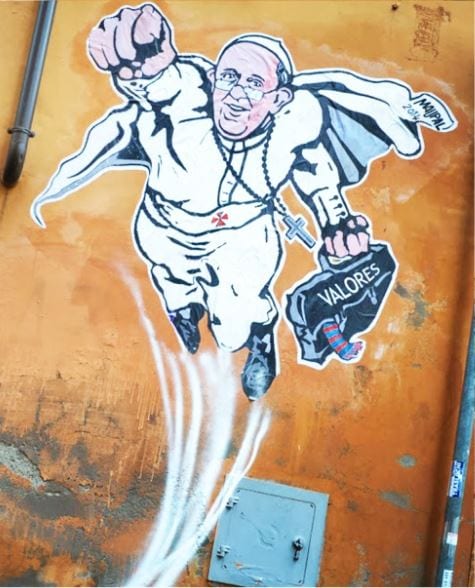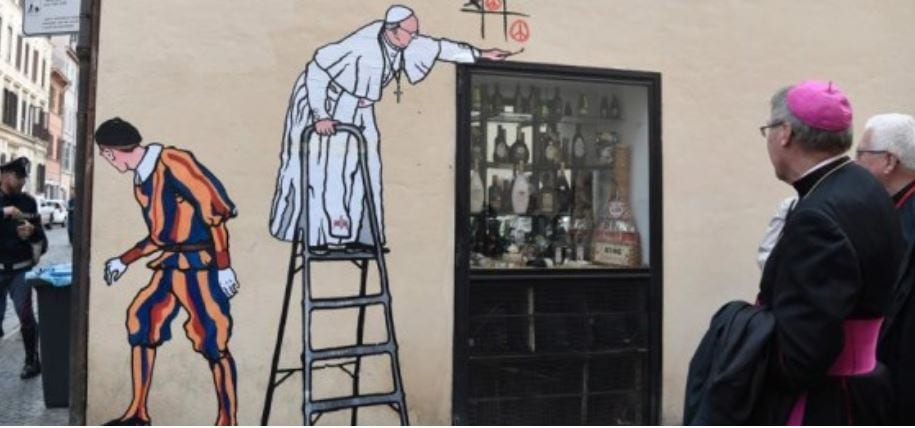Typically, the usual way we talk about the internal differences among Catholics is in terms of left v. right, liberals against conservatives. Although those terms are inexact and often misleading when applied to religious groups, there’s no denying they do capture something.
However, they’re hardly the only way of slicing the Catholic pie, and a recent ferment in Rome over a “Superpope” T-shirt neatly captures two others:
- How nervous does a Catholic get when the Church, or one of its leaders, seems popular in the outside world? Some find such acclaim exciting, seeing it as creating a powerful missionary moment, while others fret that it risks prioritizing a desire for approval over courage in proclaiming truths people don’t always want to hear.
- How comfortable is a given Catholic blending faith with commerce – that is, doing good while also turning a profit? Many would echo the sentiment of the late Archbishop Paul Marcinkus, onetime president of the Vatican bank, who famously said, “You can’t run the Church on Hail Marys alone.” Others, however, instinctively fear the corrupting power of money, especially when lust for it is hidden under a blanket of good intentions.
In brief, here’s the story of the Superpope.
An early moment when Pope Francis’s status was cemented as a pop culture sensation came on a cold Roman night in January 2014, when a street artist named Mauro Pallotta (better known as “MauPal” in the art world), painted an image of the pontiff on a wall along a much-traveled street called the Borgo Pio. It showed Francis as a superhero, flying into the sky with a curled fist in one hand and a bag of Christian values (not to mention the scarf of his favorite Argentine soccer team, San Lorenzo) in the other.

Within 48 hours, Roman authorities had scrubbed the image off the wall, but by that point the horse was out of the barn. The “Superpope” image had gone viral, with even the Vatican’s newly created Secretariat for Communications getting in on the act by tweeting out Pallotta’s image.
“For the first time in history, a pope has become POP,” Pallotta enthused. “This doesn’t just mean that the picture of the Superpope is part of pop culture and pop art. It means that Pope Francis is popular because he speaks our language, and we feel him close to us like never before.”
The Superpope image, by the way, wasn’t Pallotta’s only depiction of Francis in the Borgo Pio. Last October he put up another one, showing the pontiff playing tic-tac-toe on a wall above a shop window using peace signs rather than circles, while a Swiss Guard makes sure the coast is clear by peeking around a corner.

It was the Superpope, however, that made Pallotta a street art star.
Francis’s attitude to such images remains a bit of a mystery. On the one hand, the pope met Pallotta in an audience in late February 2014, receiving another painting from him. Pallotta also greeted Francis again this year, in July, at the end of a General Audience.
On the other hand, Francis told Italian journalist Ferrucio De Bortoli in March 2014 that “to depict the pope as a sort of superman, a kind of star, seems offensive to me … If I’m not wrong, Sigmund Freud said that in every idealization there’s an act of aggression.”
Pallotta, meanwhile, kept chugging away, launching a “Superpope” line of T-shirts based on his famous image last year. Few people made much out of it – until, that is, the T-shirts were presented earlier this month at a high-profile annual event called “Romics,” which is basically the Eternal City’s equivalent of “Comic-Con” in the States.
On the front of the T-shirt is the Superpope image, while the back carries a well-known saying of Pope Francis: “Mercy is the first attribute of God. It’s the name of God.”
Two points in particular raised eyebrows: First, that a portion of the proceeds from sales will go to support papal charities; and second, that the launch came with a direct Vatican endorsement, in the form of Italian Monsignor Dario Edoardo Viganò, who heads the Secretariat for Communications.
Viganò was clearly enthusiastic.
“In the context of a world in which everything is shouting, everything is gray, everyone’s angry, something that makes us smile and brings back a little gentleness is truly an antidote to this culture of rage and of revenge,” he said.
Asked whether such pop applications of the pope’s image risk desacralizing the office, Viganò basically dismissed the concern.
“From the very first moments, Pope Francis has presented himself as a pastor … He opted immediately for an approach based on proximity, on closeness to people,” Viganò said.
In Italy, all this has left some people cold.
Journalist Luis Badilla, who edits the widely-read Catholic blog Il Sismografo, pointed out on Tuesday that rarely does a day go by when Francis doesn’t denounce the hypocrisy of pursuing one’s own financial interests under the guise of doing good works, suggesting that “something very important isn’t right about this operation.”
(A point Badilla didn’t make, by the way, but easily could have, is that no one’s yet explained exactly how large a share of the profits will go to papal charities, and how much Pallotta and his firm stand to make in the meantime.)
No doubt, some Catholics will look on the Superpope shirt as tasteless, overly worldly, and, well, downright un-papal. Others will see its success as another chapter in the story of a pope who’s captured the imagination of the world, opening missionary doors that were previously closed.
Wherever one comes down, it seems abundantly clear Pallotta isn’t about to walk away. He’s launched a slick marketing site for the shirts in multiple languages, extolling it as “colorful, simple, comfortable and packed with energy,” and describing its aim as “to spread a message of faith with a broad and optimistic smile, like that of our beloved Pope Francis.”
How instinctively inclined a given Catholic is to buy such language, or to be skeptical of it, probably says a lot about where he or she is likely to stand on a lot of other matters too.















